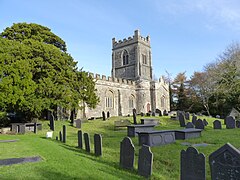Llandygai
Llandygái
| |
|---|---|
 Church of St Tegai | |
Location within Gwynedd | |
| Population | 2,487 (2011) |
| OS grid reference | SH597708 |
| Community |
|
| Principal area | |
| Country | Wales |
| Sovereign state | United Kingdom |
| Post town | BANGOR |
| Postcode district | LL57 |
| Dialling code | 01248 |
| Police | North Wales |
| Fire | North Wales |
| Ambulance | Welsh |
Arfon | |

Llandygái (
Prehistory
There is evidence of human occupation of this site from Neolithic times.
Excavations in the 1960s at the site of the current Industrial Estate uncovered two large
History

In 1648 during the
The village of Llandygái is recorded at the beginning of the nineteenth century as consisting of eight or nine houses.[7] The village was later developed by quarry owner The 1st Baron Penrhyn (1800-1886) as a ‘model village’ for his estate workers, in which ‘no corrupting alehouse’ was permitted.[5] It lies immediately outside of the walls of the Penrhyn Castle demesne walls, with the entrance to the village being some 100 yards (91 m) from the castle's Grand Lodge. Lord Penrhyn, a Scottish aristocrat, had inherited the Penrhyn Estate from his father-in-law, George Hay Dawkins-Pennant (1764-1840), in 1840.
This model village was mostly constructed in the 1840s in a ‘vernacular revival’ style which conformed to the Picturesque ideal.[8] The model village was built within the loop of the road to Conwy from where it branched off Telford’s newly built Holyhead to London road. Each house was built in a similar style but none was to be identical. They were furnished with ample gardens and the layout was such that no house’s front door faced another.
Llandygái Church


A church was founded by
The present church dates to around 1330[10][11][12] and was much restored and extended by the diocesan architect, Henry Kennedy, in 1853.[8] The church is of cruciform structure with a central tower. It is a Grade II* listed building.[13]
The church has six
In the church is a
The ecclesiastical parish of Llandygái follows the Ogwen valley southwards, giving its name also to the village of Mynydd Llandygái.
Education
There are accounts of schooling for twelve children under the Welsh Trust in the late seventeenth century, and later a circulating school established in the area in 1750.[5] Shortly after her husband's death, the first Lady Penrhyn set up a school for girls in the village[5] in what is now Neuadd Talgai.[8] A school for boys was built in 1843.[8]
The boys school, now with a twentieth century extension, forms the present-day
The village today
The model village, within the loop of the former line of the
Outside the model village are also to be found –
- Off the A5 towards Bangor:
- Off the A5 towards Bethesda:
- Parc Cegin business park (in development)
- Off the former line of the A5, now a narrow lane:
The
Spelling
The village name has been spelt also as Llandegai. The correct Welsh spelling is Llandygái, the accent signifying that the last syllable is stressed as opposed to the last-but-one, the usual pattern.[19] Llandygai is also used an alternative spelling.
See also
References
- ^ "Community population 2011". Retrieved 14 May 2015.
- ISBN 0-7524-1983-8
- ISBN 1-85760-197-1
- ^ Heneb. "Archaeology at Parc Bryn Cegin". Retrieved 27 June 2009.
- ^ ISBN 1-872424-07-4
- ISBN 0-85104-013-6
- ^ Edmund Hyde Hall (1811) A Description of Caernarvonshire (1809-1811) Caernarvonshire Historical Society, 1952
- ^ a b c d e Gwynedd Council (2006). "Llandygai Conservation Area Character Appraisal" (PDF). Archived from the original (PDF) on 30 June 2008. Retrieved 27 June 2009.
- ^ T. D. Breverton, The Book of Welsh Saints (Cyhoeddiadau Glyndŵr, 2001)
- ^ Ysgol Llandygai. "Eglwys Sant Tegai, Llandygai". Retrieved 27 June 2009.
- ^ Church in Wales. "St. Tegai". Archived from the original on 7 June 2011. Retrieved 27 June 2009.
- ^ "St. Tegai's Church". Photos of Churches. Retrieved 27 June 2009.
- ^ "Church of St Tegai, Llandygai". British Listed Buildings. Retrieved 16 December 2013.
- ^ David Gwyn (2006) Gwynedd: Inheriting a Revolution: The Archaeology of Industrialisation in North-West Wales Phillimore
- ^ "Ysgol Llandygai". Archived from the original on 1 December 2010. Retrieved 27 June 2009.
- ^ Gwynedd Council (2007). "Llandegai Gypsy Site update" (PDF). Archived from the original (PDF) on 29 June 2008. Retrieved 27 June 2009.
- ^ North Wales Probation Area. "Approved Premises". Archived from the original on 1 December 2008. Retrieved 27 June 2009.
- ^ "Bangor Cricket Club". Retrieved 27 June 2009.
- ^ Briony J. Williams (1983), Stress in Modern Welsh (Ph.D.), University of Cambridge. Distributed by Indiana University Linguistics Club
{{citation}}: CS1 maint: postscript (link)



